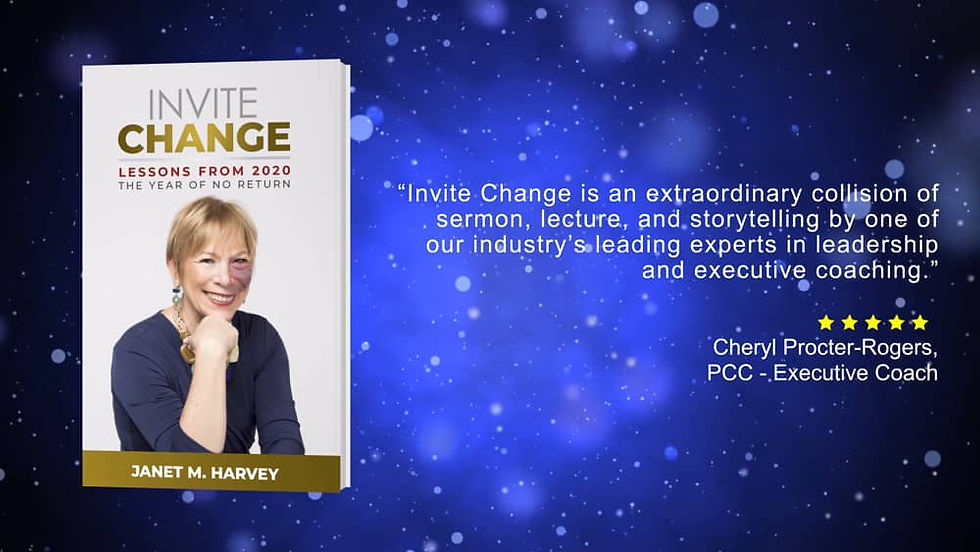How to Supercharge Design Thinking - Part One with Janet M. Harvey
- Mike Skaar
- Jul 12, 2021
- 6 min read
Updated: Feb 27, 2022
As the founder and CEO of the Knak Group, we are always looking for unique and creative ways to inspire the architects and interior designers we have the privilege of working with. As the world begins to consider a new chapter in our literal history, we are also at an inflection point for the workspace. This is Part One of a two part interview with Janet M. Harvey where we discuss how architects and designers might consider approaching that inflection point in their work. Read Part Two here.

Mike Skaar: Janet, The Knak Group is pleased to host an invitation-only webinar with you on August 3rd. I was excited to share your unparalleled expertise with all the architects and designers that we know. To help them understand the context of the webinar, can you give a quick overview of your background as a leading coach to top executives and A&D associations worldwide?
Janet M. Harvey: Thanks, Mike, for the invitation. I'm delighted to spend this time with you and your audience. When I was looking at the industries the Knak Group supports, I realized that we have a lot of clients in common. In 1996, after a long corporate career I became an entrepreneur. I began with what I knew, financial services, and quickly branched out into healthcare, technology, manufacturing, hospitality and associations, such as The American Institute of Architects and the American Red Cross.
I've been inspired and grateful for this diversity of customers as it affirmed a hypothesis I had as a leader...people are people everywhere.
What I’ve also come to notice is that any customer experience initiative is dependent upon the employee experience that leaders generate in their teams and the enterprise as a whole.
I think this is a point of intersection with what your audience cares about.
Leaders are today challenged in ways that for 60 years, we haven't asked them to think about. The hybrid workplace is the symptom of some more fundamental change occurring in what employees seek and customers expect; both elements of viable business are transforming at the same time.
In my work in coaching and learning, we've done a pretty good job of helping enterprise leaders learn about emotional intelligence and how to apply that capability to motivate their teams, do good planning and how to build trust and accountability. However, leaders struggle to navigate change without drama and disruption.
In many ways, when I named our company inviteChange in 2004, I was perhaps ahead of my time. Fast forward to today and every executive I speak with is asking the question, "Oh my gosh, how do I face everything that's happening?" Our work as coaches with individuals and teams as well as building coaching capability for leaders provides courage and confidence to answer that question creatively and congruent with their unique culture.
Mike: At the moment I'm not a huge “recreational” reader since I spend too much time on the computer reading. Okay, I'm also always reading the latest look books from our favorite brands like Wilkhahn, Muraflex and Halcon. Anyway, you happened to publish one of my favorite books called “Invite Change.” Can you tell us why you wrote the book and what you hope it can do for readers?

Janet: It's a bit of a serendipity. I never had it on my bucket list to write a book. And what life experiences in 2020 did for a lot of us, was to create, I don't know, a stimulus, a motivation to do something we never thought about before. And we gave a lot of serious thought to what's really happening here. What are we learning about in this simultaneity?
Everybody on the globe at the same time was going through the challenge that the pandemic presented in both our personal and our professional lives. And it was a reality check on meaning, purpose, values and what is my responsibility to my fellow human.
Because, of course, our actions during the pandemic would contribute to it either getting better or getting worse and how long we were enduring it. During 2020, I was inaugurating a ten-year dream to bring global leaders together. And to answer the question, how do we address social issues at the root cause?
We spend billions of dollars trying to mitigate the effect of social difficulties, the symptoms, if you will, but we're not so good at slowing down to think a little bit more critically about how we got here in the first place? And in some ways, this quest is at the root of Invite Change. The inaugural conference was in September 2020, and of course, we'd been planning pre-pandemic, and had to make a lot of agile moves during 2020.
And one of them was, the team said, "You really ought to finally write a book." They asked me in July, "Could I manage to do that by September?" Well, you know my answer, I said, “Yes.” Then I said to myself, "Are you crazy?"
So in some ways the book is a declaration of how important it is that every one of us find the courage inside to create the life we want and to have our voice and our contribution in the world shape a world where everybody gets access to the tools to create the life they want.
So the book is a mixture of my personal philosophy, my 30 years of working with executives and enterprises and their teams, and practices that I know work to assist people to architect what they want.
Mike: So when I finished reading “Invite Change,” I was compelled to call you and ask you if you wouldn't mind sharing your thoughts with my industry. You were so gracious to engage with me. What is it that excites you the most about sharing your ideas with architects and interior designers?
Janet: So there's a single word that I think we share in common and the word is experience. I happened to have an older brother, who's an architect. So, I have a little bit of insight into the worldview, the approach that goes into design. Design capability differentiates an enterprise from their competition and creates the conditions to operate effectively.
We think very clearly about how to produce more things, more opportunities, more connections, more relationships. It's a fairly transactional focus. However, the companies that are dominating their markets are the ones who take some time to say, "What is the experience of the customer that what I do contributes to in a value-added way?"
Plus a second, equally important question, “What is the experience of the employee who is producing the experience for the customer that we choose to give investment to optimize?” The solution(s) at the intersection of those two things is how companies win and learn about attracting and retaining the talent who serve their customers best. Today, the notion of being a Talent Manager is transforming into being a Talent Experience Designer.
Satya Nadella, Microsoft CEO, recently expanded how he thinks about productivity to define it more broadly. The organization recognizes that employee expectations are changing and there is a higher premium upon well-being, learning and collaboration. What do those three things have in common?
Connection person to person and open, unencumbered communication. Designers who think creatively about solving for these two conditions in any context, in person, hybrid, home office, remote from anywhere, events in any format, are going to be sought after -- for good design of course, and more importantly for solving the connection and communication challenge of our current time in history and the transformation occurring in workforce attitudes, mindset and expectations.
It may not seem relevant at first glance. However, a key motivator in our lives is feeling a sense of belonging and the biggest influence upon that feeling in our professional lives is being able to manage our effectiveness.
The design criteria that contribute most to this include working in an environment where I can feel calm, have trusting relationships, energized to engage with others, positive about my contribution and confident to fulfill my responsibilities.
Anything that creates friction for those criteria negatively impacts effectiveness, therefore belonging and for the organization, retention of precious talent. Research shows that belonging creates a 3X improvement in well-being which leads to a 2X improvement in enterprise performance in terms of gross revenue, margin and market share.
I hope you found this first part of my conversation with Janet informative and exciting. I am confident about the extraordinary information she can share to help us all think about how we are going to approach the future of the workspace.
EDITOR'S NOTE: Since we concluded this webinar, Janet has graciously made her deck available to everyone for downloading. Click the arrow below.
About the Author

Mike Skaar continues to move Knak Group forward as an industry leader in supporting progressive workplace design, innovation, and strategies to facilitate collaboration. He has been privileged to work on projects around the globe with leading architects and designers from California to the Pacific Rim. His success comes from appreciating the balance of work and life. His passions include travel, snowboarding, community service, and he has attended Burning Man 21 times and counting. Mike holds an MBA from Arizona State University and completed additional post-graduate work in international business at UCLA.
Comments